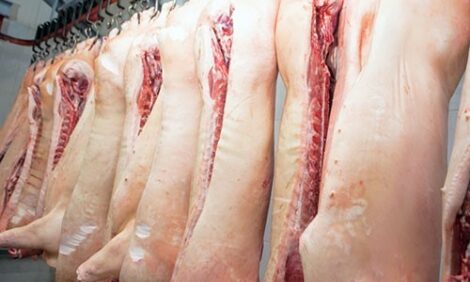



CME: Pork, Beef Prices Down Despite Drought
US - While there is broad expectation among US market participants that the surge in grain prices will eventually push beef and pork prices higher, for the moment beef and pork prices at the wholesale level are below year ago levels, write Steve Meyer and Len Steiner.The reality is that it will
take time and plenty of pain along the supply chain to reconcile higher feed costs with what the consumer is willing to
pay. On the pork side, it is important to recognize the importance
of the export market and the outsize impact it has on the overall
pricing structure. The share of US pork going to export markets
has been increasing steadily, underpinning US hog prices and helping avoid the kind of structural changes needed to cope with $6, $7
and now $8 dollar corn prices. In 2007, just as corn prices were
starting to ratchet higher, pork exports accounted for about 14% of
US pork production.
By the third quarter of 2011, however, pork
exports were 23% of overall US pork output, a dramatic increase
that helped put the pork cutout over $105/cwt. (see chart).
In the
first half of 2012, pork exports continued to be very strong, accounting for almost 25% of all US pork output. That does not necessarily
mean stronger demand given that pork prices were soft, rather,
that at the lower price levels exports were able to absorb more US
product. Going forward, it will be critical for export demand to hold
up, otherwise major reductions in hog production capacity will be
needed.
The US pork cutout on Thursday was quoted at $92.8/cwt,
$16.6/cwt or 15% lower than a year ago and also 8% lower than
what it was at the end of June. Much of the argument for the lower
year over year price decline centers around the softer outlook for
US pork exports in the second half of the year and that is likely a
driver. However, we would argue that softer domestic demand for
pork this summer clearly is a major factor. Two items have been
particularly problematic in recent weeks, loins and ribs. This past
July was the hottest on record and apparently that negatively impacted the willingness of the US consumer to spend time barbecuing in the backyard. The loin primal cutout is currently running
some 24% below year ago levels while the rib primal is down 26%
from last year. On the other hand, the belly primal is down just 2%
from a year ago while the ham primal is down 13%.
The choice beef cutout on August 9 was quoted at $1.8250/
cwt, $4.5/cwt or 3% higher than a year ago. Strong promotions of
choice beef at retail helped the cutout hit annual highs in June but
then prices slipped in July as hot weather took its toll. The expectation is for choice beef to track near or above 2011 prices into the
fall as cattle and beef supplies continue to decline. There is plenty
of talk about cattle herd liquidation but it is important to put that
portion of the beef supply in context. Most of the cattle coming to
market are feedlot animals. Feedlot cattle slaughter currently is
running at a weekly pace of around 500-520k head per week compared to cow/bull slaughter of around 127—133k head per week.
So even as cow slaughter is expected to increase to around 140-
150k per week into September and October, limited fed cattle
kills will keep overall beef supplies in check, likely down about
5% for Q3 and –3.6% for Q4.









